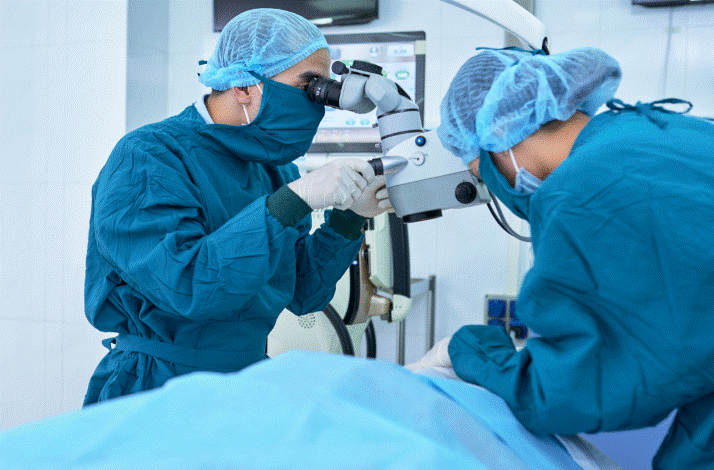Arthroscopic Surgery
DEFINITION
Arthroscopic surgery is a minimum invasive procedure for visualizing, diagnosing, and treating problems inside joints through tiny incisions.
The name originates from the Greek words arthro for joint and skopein, meaning “to look.”
Arthroscopy is performed using an arthroscope, a pencil-sized, fiber-optic instrument with a magnifying lens and lighting system passed through a small incision for a close look inside a joint.
Attaching a tiny video camera to the arthroscope provides a clearer view of the joint interior without a larger surgical incision.
PURPOSE
Arthroscopic surgery is performed to diagnose, treat, and monitor acute or chronic injuries and diseases that affect the joints.
Diagnostic arthroscopic surgery is performed when other assessments—such as medical history, physical exam, x rays, or bone scans—do not provide a final diagnosis.
Corrective arthroscopic surgery is used mainly to remove bone or cartilage or repair tendons or ligaments.
DEMOGRAPHICS
Knee arthroscopy is the most used orthopedic procedure. Some 2 million arthroscopic knee surgeries are performed worldwide each year, along with some 1.4 million arthroscopic shoulder surgeries.
There are no significant differences among ethnicities or age brackets for people having arthroscopic surgeries.
However, people under the age of 40 tend to be more prone to athletic injuries diagnosed and repaired by arthroscopic procedures.
Older patients may have arthroscopic procedures to diagnose, treat, or repair issues related to the normal aging processes in place of or before undergoing extensive surgical procedures such as total joint replacement.
DESCRIPTION
Arthroscopic surgery can be implemented on any joint in the body but most commonly on the knees and shoulders and ankles, wrists, elbows, and hips.
In contrast to the large incisions required in open surgical procedures, arthroscopy is performed with incisions as small as 0.25 (1 cm).
The diagnostic accuracy of arthroscopy is 100%, compared to diagnostic imaging techniques such as magnetic resonance imaging (MRI).
Arthroscopic surgery can be used to ease mechanical joint issues such as buckling, stiffness, or locking and may preclude or delay the need for more aggressive surgery such as joint replacement.
Recovery is faster with arthroscopic surgery since it is less invasive. Scarring is also reduced.
In arthroscopic surgery, an orthopedic surgeon uses an arthroscope fitted with a lens, light source, and a miniature video camera to examine and treat structures inside a joint, including bones, cartilage, and surrounding tissue.
Advanced fiber optics developed in the 1970s and 1980s enables the visualization of even more detail than can be seen in open surgery, often identifying problems that may be difficult to diagnose by other methods.
Highlighted images of the structures are transmitted to a television monitor in the operating room.
The class and extent of the injury can be determined, and repair or correction can be performed simultaneously if needed.
A few of the most common joint problems diagnosed and treated with arthroscopic surgery are:
- synovitis (inflamed joint lining) of the knee, shoulder, elbow, wrist, or ankle
- knee injuries, including meniscal (cartilage) tears, wearing down of or injury to the cartilage cushion, and anterior cruciate ligament tears with instability
- shoulder injuries, including rotator cuff tendon tears, impingement syndrome, shoulder instability, and dislocations
- wrist injuries such as carpal tunnel syndrome
- loose bone and/or cartilage in the knee, shoulder, elbow, ankle, or wrist
- torn floating cartilage or surface cartilage
- joint damage caused by rheumatoid arthritis or osteoarthritis
Arthroscopic operations are performed in a hospital or outpatient surgical facility by an orthopedic surgeon.
The choice of anesthesia (local, spinal, or general) and length of the procedure vary depending on the joint, the type and extent of the injury, and/or the complexity of the repair.
Arthroscopic surgery seldomly lasts more than an hour. Most subjects who have arthroscopic surgery, whether diagnostic or corrective, are discharged on the same day as the procedure, although some patients may need to stay in the hospital for one or two days.
Considered the most important orthopedic development of the twentieth century, arthroscopic surgery is performed by 80% of all orthopedic surgeons, and its use on famous athletes has been well-publicized.
Initially, arthroscopic surgery was a diagnostic tool used before open surgery; however, improved instrumentation and techniques have led to its use for treating a variety of joint issues, frequently avoiding more difficult surgeries with longer recuperation times.
New techniques currently under development will probably lead to arthroscopic surgeries for other joints, even small finger and toe joints.
Laser technology came to light as a treatment option in arthroscopic surgery, and other advanced technologies are being explored.
Surgical procedure
The surgeon makes two small incisions about the size of a buttonhole in the skin near the joint.
A sterile sodium chloride solution is injected through one incision to expand the joint to better view and move the instruments.
The area is irrigated (flooded with fluid) to distend the joint and remove blood and debris for increased visibility.
The arthroscope is inserted into the second incision. By viewing the joint’s interior on a television monitor, the surgeon can determine the type and extent of the injury and, if necessary, repair or treat the problem or take a biopsy specimen for later pathologic examination.
A third tiny incision may be made to see other parts of the joint or insert additional instruments, such as a laser or tiny scalpels, to make repairs.
Arthroscopic surgery may be used to remove floating bits of cartilage, to debride (clean) surfaces by extracting tissue or bone, and to treat minor tears and other disorders.
After the operation, the arthroscope is removed, and the joint is again irrigated.
Absorbable sutures may be applied to the incision sites, and the site is typically dressed with compression bandages (Ace bandages).
PRECAUTIONS
Diagnostic or therapeutic arthroscopic surgery is not recommended unless other diagnostic procedures have not identified the joint problem or nonsurgical treatments have been unsuccessful.
In 2017, an international panel reported that knee arthroscopy is often a waste of time and money and little use in patients with degenerative knee disease, affecting approximately 25% of people over age 50.
PREPARATION
Before arthroscopic surgery, the patient’s medical history will be reviewed, and a complete physical examination will be performed.
Regular pre-operative blood and urine tests will be performed, along with diagnostic imaging such as MRI, computed tomography (CT) scans, or arthrography (enhanced x rays using dye).
In certain cases, an exercise regimen or muscle stimulation treatment (transcutaneous electrical nerve stimulation or TENS) can be recommended to strengthen muscles around the joint before surgery.
Preoperative guidelines may include:
- discontinuing aspirin and anti-inflammatory medications two weeks before surgery
- stopping smoking from encouraging postoperative healing
- informing the surgeon of any fever or other illness or cuts, scratches, or bruises near the surgical site
- not eating, drinking, or chewing gum for 12 hours before surgery
- wearing loose-fitting clothing to allow for bulky dressings over the surgical site
- having crutches or a walker available after hip, knee, or ankle arthroscopy
AFTERCARE
Instantly after the procedure, the patient will spend up to two hours in a recovery area before being discharged.
Patients can be transferred to a hospital room if the surgeon determines that overnight care is required.
The surgical site will be prepared with a compression bandage or a firmly fitting stocking (support hose). An ice pack shall be placed on the joint.
This treatment can continue for up to 72 hours after surgery to keep swelling down and help prevent the formation of blood clots.
Pain medicament will be given if required, although many patients take little or no drugs for pain.
Fitting may usually be removed the next morning after surgery and interchanged by adhesive bands.
The surgeon should be alerted if the subject experiences any escalation in pain, swelling, redness, drainage, or bleeding at the surgery site, signs of infection (headache, muscle aches, dizziness, fever), or nausea or vomiting.
Incision wounds typically heal within several days, but it may take several weeks for the joint to recover fully.
Most patients may resume their everyday activities within a few days after the procedure, including going back to work.
Muscle strength has to be regained as soon as can post-surgery to aid support the concerned joint.
A rehabilitation plan, including physical therapy, could be suggested to speed recovery and improve joint functioning.
The surgeon’s recommendations for recovery may include:
- keeping the surgical site and dressings clean and dry
- using ice packs for up to 72 hours to reduce pain and swelling
- elevating the affected joint (wrist, elbow, ankle, or knee) on pillows and exercising gently to encourage circulation
- temporarily using a knee brace or shoulder sling
- performing weight-bearing exercise as appropriate
RISKS
Complications are reported in fewer than 1% of all arthroscopies.
Complications that do occur are those associated with any invasive surgery, including infection, blood clot formation, swelling, bleeding, or damage to blood vessels or nerves.
Rare instrument breakage during procedures has been reported.
RESULTS
Most of the patients undergo arthroscopic surgery as outpatients and are home within a couple of hours or, in most cases, a day or two.
Pain and complications are seldom, and most patients experience improved mobility and stability and less pain as they recover during a period of days, possibly with the aid of physical therapy and gentle exercise.
Patients may not regain all of their previous strength in the affected joint.
Some people undergoing arthroscopy have preexisting conditions or diseases that will affect the surgical result.
Recovery times vary depending on each patient’s overall condition, and recovery times can belong.
Certain problems may require treatment with a combination of arthroscopic and open surgical procedures.
ALTERNATIVES
Alternatives to arthroscopic surgery include:
- avoidance of strenuous or demanding activities
- use of anti-inflammatory medications
- physical therapy and appropriate gentle exercise, such as yoga
- use of a brace or walking aid
- glucosamine sulfate and chondroitin as nutritional supplements to help reduce pain and stiffness
- therapeutic massage, acupuncture, or other bodywork
Resources
Benoit, Joan. “The Advent of Arthroscopic Surgery.” In That’s Gotta Hurt: The Injuries That Changed Sports Forever, edited by David Geier. Lebanon, NH: ForeEdge, 2017.
Ferkel, Richard D., ed. Foot and Ankle Arthroscopy, 2nd ed. Philadelphia: Wolters Kluwer, 2017.
Phillips, B. B. “Arthroscopy of the Upper Extremity.” In Campbell’s Operative Orthopaedics, edited by F. M. Azar, J. H. Beaty, and S. T. Canale, 13th ed. Philadelphia: Elsevier, 2017.
Savoie, Felix H., Larry D. Field, and S. Steinmann. The Elbow and Wrist: AANA Advanced Arthroscopic Surgical Techniques. Thorofare, NJ: Slack, 2016.
Brody, Jane E. “What I Wish I’d Known About My Knees.” New York Times (July 4, 2017): D5.
Davis, Jennifer. “Arthroscopic Surgery May Not Ease Pain.” Arthritis Today 29, no. 6 (November/December 2015): 46.
Domb, Benjamin G., et al. “Clinical Outcomes of Hip Arthroscopic Surgery: A Prospective Survival Analysis of Primary and Revision Surgeries in a Large Mixed Cohort.” American Journal of Sports Medicine 44, no. 10 (October 2016): 2505–17.
Dyrna, Felix, et al. “Stem cell procedures in arthroscopic surgery.” European Journal of Medical Research, vol. 21, no. 1, 2016.
Lukits, Ann. “The Research Report: Knee Surgery May Not Be Best Option for Older Patients.” Wall Street Journal (June 23, 2015): D4.
Thorlund, J. B., et al. “Arthroscopic Surgery for Degenerative Knee: Systematic Review and Meta-Analysis of Benefits and Harms.” British Journal of Sports Medicine 49, no. 19 (October 2015): 1229.
“A Patient’s Guide to Arthroscopic Shoulder Surgery—Chapter 1.” Southern California Orthopedic Institute. https://www.scoi.com/patient-resources/videos/chapter-1-patients-guide-arthroscopic-shoulder-surgery (accessed December 4, 2017).
“Posterior Ankle Endoscopy or Arthroscopy.” American Orthopaedic Foot & Ankle Society. http://www.aofas.org/footcaremd/treatments/Pages/Posterior-Ankle-Endoscopy-or-Arthroscopy.aspx (accessed December 4, 2017).
“Shoulder Arthroscopy.” MedlinePlus. November 6, 2017. https://medlineplus.gov/ency/article/007206.htm (accessed December 4, 2017).
“Subtalar Arthroscopy.” American Orthopaedic Foot & Ankle Society. http://www.aofas.org/footcaremd/treatments/Pages/Subtalar-Arthroscopy.aspx (accessed December 4, 2017).
Wilkerson, Rick. “Knee Arthroscopy.” OrthoInfo. September 2016. https://orthoinfo.aaos.org/en/treatment/knee-arthroscopy (accessed December 9, 2017).
American Academy of Orthopaedic Surgeons, 9400 W. Higgins Rd., Rosemont, IL 60018-4976, (847) 823-7186 orthoinfo@aaos.org, https://orthoinfo.aaos.org.
American Orthopaedic Foot & Ankle Society, Orthopaedic Foot & Ankle Foundation, 9400 W. Higgins, Rd., Ste. 220, Rosemont, IL 60018, (847) 698-4654, (800) 235-4855, (847) 692-3315 aofasinfo@aofas.org, http://www.aofas.org.
American Orthopaedic Society for Sports Medicine, 9400 W. Higgins Rd., Ste. 300, Rosemont, IL 60018, (847) 292-4900, (877) 321-3500, (847) 292-4905 info@aossm.org, http://www.sportsmed.org.
Arthroscopy Association of North America, 9400 W. Higgins Rd., Ste. 200, Rosemont, IL 60018, (847) 292-2262, (847) 292-2268 info@aana.org, http://www.aana.org.









